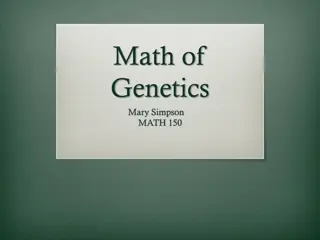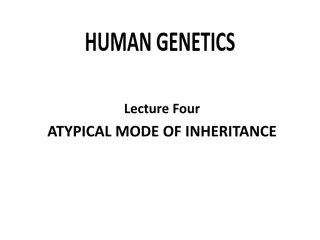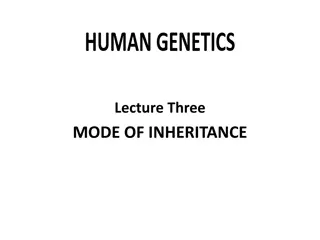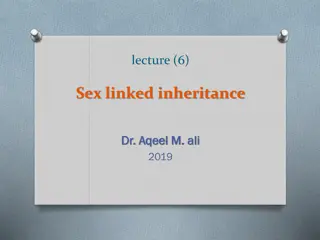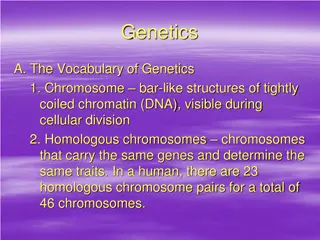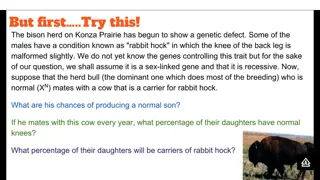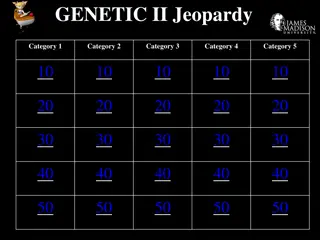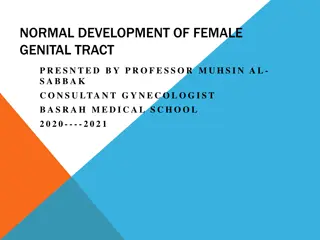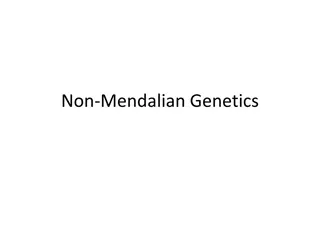Understanding Sex Determination and Sex Linked Inheritance in Genetics Lecture
Explore the principles of inheritance of characteristics encoded by genes on sex chromosomes, known as sex-linked traits. Delve into the mechanisms of sex determination across species, from monoecious organisms to dioecious species like humans. Understand primary and secondary sexual characteristics, sexual dimorphism, and mechanisms of sex determination in living organisms.
Uploaded on Jul 22, 2024 | 1 Views
Download Presentation

Please find below an Image/Link to download the presentation.
The content on the website is provided AS IS for your information and personal use only. It may not be sold, licensed, or shared on other websites without obtaining consent from the author. Download presentation by click this link. If you encounter any issues during the download, it is possible that the publisher has removed the file from their server.
E N D
Presentation Transcript
genetic course lecture (5) Determination of sex Dr. israa hussein hamzah email: esraa_hassan17@yahoo.com szsh@uomustansiriyah.edu.iq Reference book: genetic (Conceptual- Approach) fourth edition (2012) Author: Benjamin C. Pierce
In this lecture , we explore other major extensions of Mendel s principles: the inheritance of characteristics encoded by genes located on the sex chromosomes, which often differ in males and females. These characteristics and the genes that produce them are referred to as sex linked. To understand the inheritance of sex-linked characteristics, we must first know how sex is determined why some members of a species are male and others are female.
Members of almost all species are often divided into two sections according to the kind of gamete or sex cell produced by them, i.e., male sex and female sex. The word sex has been derived from Latin word sexus meaning section or separation. However, some of the lowest forms of plant and animal life are found to have several sexes. For example, in one variety of the ciliated protozoan Paramecium bursaria there are eight sexes or matingtypes all morphologically identical. Each mating type is physiologically incapable of conjugating with its own type, but may exchange genetic material with any of the seven other types within the same variety.
There are many ways in which sex differences arise. In some species, both sexes are present in the same organism, a condition termed hermaphroditism; organisms that bear both male and female reproductive structures are said to be monoecious (meaning onehouse ). In plants where staminate (male) and pistillate (female) flowers occur on the same plant, the term of preference is monoecious. Most of our flowering plants have both male and female parts within the same flower (called perfect flower). Species in which the organism has either male or female reproductive structures are said to be dioecious (meaning two houses ). Humans are dioecious. Among dioecious species, sex may be determined chromosomally, environmentally. genetically, or
The sex cells and reproductive organs form the primary sexual characters of male and female sexes. Besides these primary sexual characters, the male and female sexes differ from each other in many somatic characters known as secondary sexual characters. The phenomenon of molecular, morphological, physiological or behavioral differentiation between male and female sexes is called sexual dimorphism. Modern geneticists have mechanisms of determination of sex in living organisms. Some important and common mechanisms of sex determination are following : reported many different
mechanisms of sex determination 1. Sex chromosome mechanism or Heterogamesis; 2. Genic balance mechanism; 3. Male haploidy or haplodiploidy mechanism; 4. Single gene effects.
1- Chromosomal Sex-Determining Systems The chromosome theory of inheritance include that the genes are located on chromosomes, which serve as vehicles for the segregation of genes in meiosis. Definitive proof of this theory was provided by the discovery that the sex of certain insects is determined by the presence or absence of particular chromosomes. In 1891, Hermann Henking noticed a peculiar structure in the nuclei of cells from male insects. Understanding neither its function nor its relation to sex, he called this structure the X body. Later, Clarence E. McClung studied the X body in grasshoppers and recognized that it was a chromosome. McClung called it the accessory chromosome, but it eventually became known as the X chromosome, from Henking s original designation.
McClung observed that the cells of female grasshoppers had one more chromosome than the number of chromosomes in the cells of male grasshoppers, and he concluded that accessory chromosomes played a role in sex determination. In 1905, Nettie Stevens and Edmund Wilson demonstrated that, in grasshoppers and other insects, the cells of females have two X chromosomes, whereas the cells of males have a single X. In some insects, they counted the same number of chromosomes in the cells of males and females but saw that one chromosome pair was different: two X chromosomes were found in female cells, whereas a single X chromosome plus a smaller chromosome, which they called Y, was found in male cells.
Stevens and Wilson also showed that the X and Y chromosomes separate into different cells in sperm formation; half of the sperm receive an X chromosome and the other half receive a Y. All egg cells produced by the female in meiosis receive one X chromosome. A sperm containing a Y chromosome unites with an X-bearing egg to produce an XY male, whereas a sperm containing an X chromosome unites with an X-bearing egg to produce an XX female. This distribution of X and Y chromosomes in sperm accounts for the 1 : 1 sex ratio observed in most dioecious organisms Because sex is inherited like other genetically determined characteristics, Stevens and Wilson s discovery that sex is associated with the inheritance of a particular chromosome also demonstrated that genes are on chromosomes. As Stevens and Wilson found for insects, sex in many organisms is determined by a pair of chromosomes, the sex chromosomes, which differ between males and females.
TYPES OF SEX CHROMOSOMAL MECHANISM OF SEX DETERMINATION In dioecious diploidic organisms following two systems of sex chromosomal determination of sex have been recognized: (a) Heterogametic males; (b) Heterogametic females. Heterogametic Males In this type of sex chromosomal determination of sex, the female sex has two X chromosomes, while the male sex has only one X chromosome. Because, male lacks a X chromosome, therefore, during gametogenesis gametes, 50 per cent gametes carry the X chromosomes, while the rest 50 per cent gametes lack in X chromosomes. Such a sex which produces two different type of gametes in terms of sex chromosomes is called heterogametic sex. The female sex, because, produces similar type of gametes, is called, homogametic sex. The heterogametic males may be of following two types:-
(i) XX-XO sex determination The mechanism of sex determination in the grasshoppers studied by McClung is one of the simplest mechanisms of chromosomal sex determination and is called the XX-XO system. and insects specially those of the orders Hemiptera (true bugs) and Orthoptera(grasshoppers and roaches). In this system, females have two X chromosomes (XX), and males possess a single X chromosome (XO). There is no O chromosome; the letter O signifies the absence of a sex chromosome. In meiosis in females, the two X chromosomes pair and then separate, with one X chromosome entering each haploid egg. In males, the single X chromosome segregates in meiosis to half the sperm cells; the other half receive no sex chromosome. Because males produce two different types of gametes with respect to the sex chromosomes, half with X chromosome and half without X chromosome. The sex of the offspring depends upon the sperm that fertilizes the egg (each of which carries a single X chromosome). they are said to be the heterogametic sex.
Females, which produce gametes that are all the same with respect to the sex chromosomes, are the homogametic sex. In the XX-XO system, the sex of an individual organism is therefore determined by which type of male gamete fertilizes the egg. X-bearing sperm unite with X-bearing eggs to produce XX zygotes, which eventually develop as females. Sperm lacking an X chromosome unite with X- bearing eggs to produce XO zygotes, which develop into males.
(ii) XX-XY sex determination : In many species, insects(Drosophila ) , reptiles, and all mammals (including humans ) males and females have the same number of chromosomes, but the female possesses two X chromosomes in their body cells hence, referred to as( XX) and they being homogametic, produce one kind of eggs, and the cells of males have a single X chromosome and a smaller sex chromosome, the Y chromosome (XY). In humans and many other organisms, the Y chromosome is acrocentric not Y shaped as is commonly assumed. In this type of sex-determining system, the male is the heterogametic sex half of his gametes have an X chromosome and half have a Y chromosome. The sex of embryo depends on the kind of sperm. An egg fertilized by a X-bearing sperm, produces a female, but, if fertilized by a Y-bearing sperm, a male is produced Many organisms, including some plants,
heterogametic Females In this type of sex chromosomal determination of sex, the male sex possesses two homomorphic X chromosomes, therefore, is homogametic and produces single type of gametes, each carries a single X chromosome. The female sex either consists of single X chromosome or one X chromosome and one Y chromosome. The female sex is, thus, heterogametic and produces two types of eggs, half with a X chromosome and half without a X chromosome (with or without a Y chromosome). To avoid confusion with that of XX-XO and XXXY types of sex determining mechanisms, instead of the X and Y alphabets, Z and W alphabets are generally used respectively. The heterogametic females may be of following two types :
(i) ZO-ZZ system This system of sex determination is found in certain moths and butterflies. In this case, the female possesses single Z chromosome in its body cells (hence, is referred to as ZO) and is heterogametic, producing two kinds of eggs, half with a Z chromosome and half without any Z chromosome. The male possesses two Z chromosomes (hence, referred to as ZZ) and is homogametic producing single type of sperms, each of which carries a single Z chromosome. The sex of the offspring depends on the kind of egg as shown below : Parent : Female X Male 2A+ZO 2A+ZZ Gametes : (A+Z) (A+O) (A+Z) (A+Z) Ova Sperms F1 : 2A+ZZ , 2A+ZO Male, Female
(ii) ZW-ZZ system. This system of sex determination occurs in certain insects (gypsy moth) and vertebrates such as fishes, reptiles and birds and plants such as Fragaris elatior. Here the female sex has one Z chromosome and one W chromosome. It is heterogametic and produces two types of ova, 50 per cent ova carry the Z chromosomes, while rest 50 per cent ova carry W chromosomes. The male sex has two homomorphic Z chromosomes and is homogametic producing single type of sperms, each carries a Z chromosome. The sex of the offspring depends on the kind of egg, the Z bearing eggs produces males but the W bearing eggs produce females . Parent : Female X Male 2A+Zw 2A+ZZ Gametes : (A+Z) (A+w) (A+Z) (A+Z) Ova Sperms F1 : 2A+ZZ , 2A+Zw Male, Female
2- Genic Balance Mechanism By studying sex chromosomal mechanism of sex determination, it may appear at first glance that some genes carried by the sex chromosomes (X and Y) were entirely responsible for sex. But this is not the case. Extensive experimentation of different workers (Wilson, 1909 ; Bridges,1921 and Goldschmidt, 1934) on different organisms have revealed the fact that most organisms generally have inherent potentialities for both sexes and each individual is found to be more or less intermediate between male and female sexes (Hence may be referred to as intersex). first of all studied in Drosophila by C.B. Bridges in 1921. The theory of genic balance given by Calvin Bridges (1926) states that instead of XY chromosomes, sex is determined by the genic balance or ratio between X- chromosomes and autosome genomes. In this system, a number of different genes influence sexual development. The X chromosome contains genes with female-producing effects, whereas the autosomes contain genes with male-producing effects. Consequently, a fly s sex is determined by the X : A ratio , the number of X chromosomes divided by the number of haploid sets of autosomal chromosomes
Sex determination in Drosophila. In Drosophila, the presence of Y chromosome has been found essential for the fertility of male sex but that has nothing to do with the determination of male sex. In this fly, the sex is determined polygenically. The sex of an individual then depends upon the ratio of X chromosomes to autosomes. The fruit fly Drosophila melanogaster has eight chromosomes: three pairs of autosomes and one pair of sex chromosomes. Thus, it has inherited one haploid set of autosomes and one sex chromosome from each parent. Normally, females have two X chromosomes and males have an X chromosome and a Y chromosome. However, the presence of the Y chromosome does not determine maleness in Drosophila; instead, each fly s sex is determined by a balance between genes on the autosomes and genes on the X chromosome.
An X : A ratio of 1.0 produces a female fly; an X : A ratio of 0.5 produces a male. If the X : A ratio is less than 0.5, a male phenotype is produced, but the fly is weak and sterile such flies are sometimes called metamales. An X : A ratio between 1.0 and 0.5 produces an intersex fly, with a mixture of male and female characteristics. If the X : A ratio is greater than 1.0, a female phenotype is produced, but this fly (called a metafemale) has serious developmental problems and many never complete development. Table presents some different chromosome complements in Drosophila and their associated sexual phenotypes. Normal females have two X chromosomes and two sets of autosomes (XX, AA), and so their X : A ratio is 1.0. Males, on the other hand, normally have a single X and two sets of autosomes (XY, AA), and so their X : A ratio is 0.5. Flies with XXY sex chromosomes and two sets of autosomes (an X : A ratio of 1.0) develop as fully fertile females, in spite of the presence of a Y chromosome. Flies with only a single X and two sets of autosomes (XO, AA, for an X : A ratio of 0.5) develop as males, although they are sterile. These observations confirm that the Y chromosome does not determine sex in Drosophila.
Chromosome complements and sexual phenotypes in Drosophila Sets of X : A Complement Autosomes Ratio sexual Phenotype Sex- Haploid Chromosome complement XX AA 1.0 Female XY AA 0.5 Male XO AA 0.5 Male XXY AA 1.0 Female XXX AA 1.5 Metafemale XXXY AA 1.5 Metafemale XX AAA 0.67 Intersex XO AAA 0.33 Metamale XXXX AAA 1.3 Metafemale
Triploid (female) diploid male 3A+XXX 2A+ XY A+X A+Y Triploid female Triploid intersex 2A+XX 3A+XXX Diploid female 3A+XXY Diploid male A+X 2A+XX Triploid intersex 2A+XY Super male 2A+x 3A+XX 3A+XY A+XX Super female Diploid female 2A+XXX 2A+XXY Fig. Results obtained from a Bridge s classical cross of a triploid (3A+XXX) female fly and a diploid (2A+XY) male fly (Drosophila).
3- Male Haploidy or Haplodiploidy Mechanism Male haploidy or haplodiploidy or arrhenotokous parthenogenesis is particularly common in the hymenopterous insects such as ants, bees, sawflies and wasps (e.g., Bracon hebetor). In these insects, since, fertilized eggs develop into diploid females and unfertilized ones into haploid males; so arrhenotoky is both a form of reproduction and a means of sex determination. Meiosis is normal in females, but crossing over and reduction in chromosome number fail to occur during spermatogenesis in males due to their haploidy For example, a honeybee queen (whose diploid number is32) can lay two types of eggs. By controlling the sphincter of her sperm receptacle (which holds sperms previously obtained in matings with males during nupital flight), she produces a fertilized egg (a diploid zygote having 32 chromosomes and developing into a female) or an unfertilized egg (a haploid zygote having 16 chromosomes and developing into a male). The diploid female zygotes can differentiate into either workers(sterile) or queens (fertile) depending on the diet they consume during their development.
4- Single Gene Control of Sex In certain organisms, for example Chlamydomonas, Neurospora, yeast, Asparagus, maize, Drosophila, etc., individual single genes are found to be responsible for the determination or expression of sex, following cases exemplified the single gene control of sex : (a) Sex-determination in Asparagus. Asparagus is a dioecious plant, however, sometimes the female flowers bear rudimentary anthers and the male flowers bear rudimentary pistils. Thus, sometime when the seeds of such a rare male flower were raised into plants, then, the male and female plants were found to be present in 3 : 1 ratio. When the male plants raised thus were used to pollinate the female flowers on female plants, only two third of them showed segregation indicating that the sex is controlled by a single gene.
Rare male plant Pp Selfed PP Pp PP (25%) Female (% 25)MALE 50% male in Asparagus showing monogenic control. Segregation for sex in seed obtained from a rare bisexual flower


